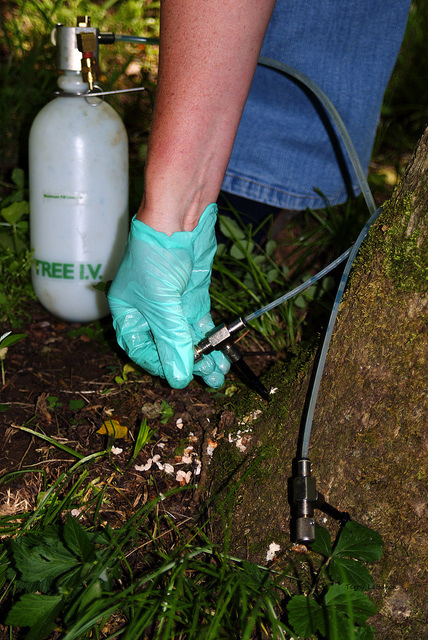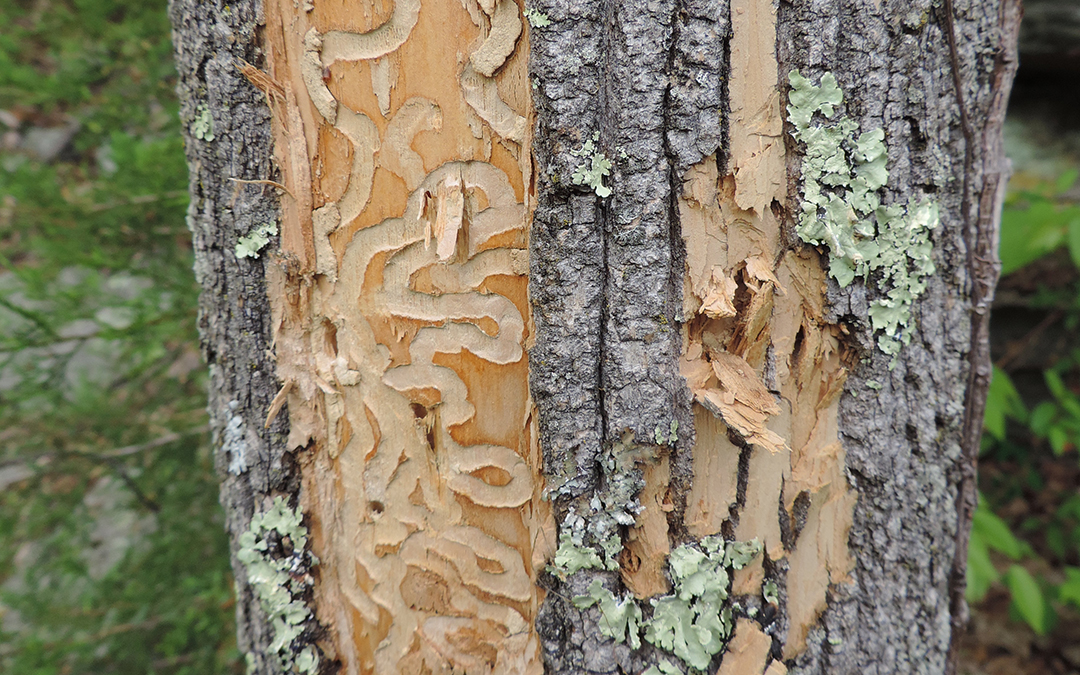Small things can have big impacts. Last weekend my extended family gathered on my parent’s eastern Pennsylvania property because of a beetle. They recently cut down over 30 trees in their yard. It seems like a radical and destructive move. As we spent the weekend cutting, splitting and stacking wood for the stove, their choice to cut down the trees was affirmed. Under the bark there were endless twisting and turning tunnels where the larva of Emerald Ash Borers ate into the wood, killing the trees.

Lots of firewood ready to split. Photo by Katie Finch
In any environment, species are part of a system, connected to each other. Some connections we understand, others are still a mystery. In our native ecosystems, there is a balance. The animals and plants that evolved together develop beneficial relationships or defenses against one another in order to survive. When an invader comes in from outside the system, it throws the balance off, sometimes with drastic effects.
Emerald Ash Borers (Agrilus planipennis) are one of those invaders in North America. This metallic green beetle, native to Asia, is thought to have traveled over with wooded packaging in the late 1900s. Unlike the relationship with native wood boring beetles in North America, ash trees haven’t developed a resistance to Emerald Ash Borer (EAB). So it is spreading rapidly among forests and urban landscapes killing hundreds of millions of ash trees.
Female beetles lay eggs on the ash bark. After hatching, the larva burrow into the tree. Just under the bark, they chew back and forth, out of sight, eating the very layer where the tree transports water and nutrients. In several years, the tree can lose its transportation system and essentially starve to death.
When the adult beetle emerges from the tree it doesn’t travel far to find a mate- about one mile at the most. But when humans transport the trees, lumber and firewood we can unknowingly move the beetle, eggs or larva, spreading this invader more rapidly across the country.
The ash trees in my parents’ yard are a loss. So many mature trees on the ground leave a big hole in the landscape but also in my heart. As a child, the grayish, diamond patterned trunks were often examined to find the perfect place to put a hammock. The compound leaves created canopies of shade to play and picnic under.
These trees framed our yard but were not center stage. They didn’t have broad, low branches for swings, tree houses or climbing adventures. They produced no food we could eat. They didn’t turn a remarkable color in the fall or have brilliant fragrant blooms in spring. The ash trees were always there but not really noticed- until they were gone.

One option to protect ash trees from Emerald Ash Borer is to treat the trees with an insecticide pumped into the tree. Photo by Terry LeBaron.
Why does it matter? While not as stately as oak or as tasty as sugar maple, ash is an important tree. In urban landscapes it is a common shade tree. In my neighborhood, there is a street almost entirely lined with ash. As a commercial product ash is valued for its strength, hardness and ability to resist shock, making it ideal for handles, tools and baseball bats.
In a forest setting, ash trees fill a specific niche. As fields naturally transition to forest, every plant has a role. Sun loving cedar, aspen, and birch sprout among the grasses and flowers. As those rapidly grow, ash seed fly in and germinate in their shade. But ash soon pop through and grow above the sun loving trees to create the next layer of the forest. The ash then create shade for longer lived trees that define a mature forest such as oak, hickory, maple and beech. Ash is an in between tree.
My parents’ property was abandoned farm land. After 50 years unplowed and un-grazed, it was changing back into a forest. In an intermediate stage ash was prevalent. For every ash tree they cut, there was at least one left standing that was a little farther away from the house. All were dying from EAB.
Dead trees aren’t bad. They provide shelter and food for wildlife. With all the EAB larva in the ash, the presence of woodpeckers at my parents’ was astounding. Downy, Hairy, Red-bellied, Pileated Woodpeckers as well as Yellow-bellied Sapsuckers were heard calling and drumming all weekend. As the birds seek the larva inside the tree with their pounding bills, the gray bark is peeled off revealing a blond color underneath. In fact, the feeding is so heavy it is noticeable while driving by infested areas along the highway at 65 miles per hour.
My parents chose to cut down their ash trees because they were clearly infected with EAB and they would become hazards as they died. And they need the firewood. As EAB spreads we have to choose how to deal with this change and what to replace the trees with in our urban and rural landscapes.
Small things can have big impacts. This metallic green beetle, about the size of a cooked grain of rice is changing the makeup of our landscapes. But I have faith in the natural world. We have seen this before. And while the loss of a species is a detriment to the ecosystems it is a part of and to the people that use it, nature is resilient. And the small things that we as humans do matter for both the bad and the good.
Audubon Community Nature Center builds and nurtures the connections between people and nature. The trails are open for hiking or skiing from dawn to dusk and the Nature Center is open from 10:00 a.m. – 4:30 p.m. daily except Sundays when it opens at 1:00 p.m. Visit auduboncnc.org for more information or call (716) 569-2345.
Katie Finch is a naturalist at ACNC.


Recent Comments